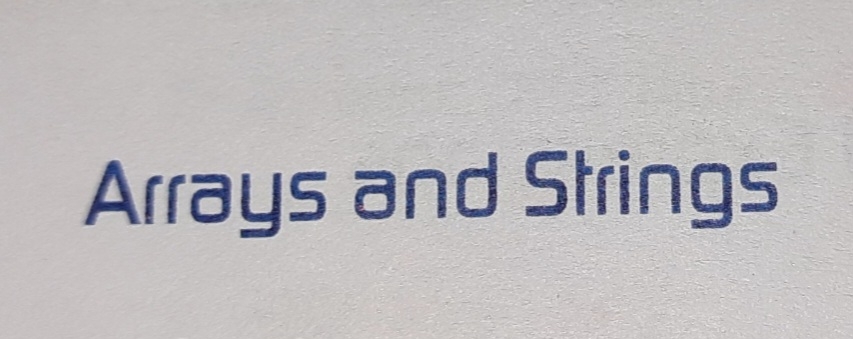Title: Exploring the World of Arrays: A Comprehensive Guide
Introduction
Arrays are one of the fundamental data structures in computer science and programming. They play a pivotal role in storing and managing collections of data. Whether you're a beginner taking your first steps in programming or an experienced developer working on complex algorithms, a deep understanding of arrays is essential. In this comprehensive guide, we will explore arrays in-depth, covering their definition, types, operations, and real-world applications.
## Chapter 1: What is an Array?
### 1.1 Definition
An array is a data structure that stores a fixed-size, ordered collection of elements of the same data type. These elements, often referred to as "items" or "elements," are stored in contiguous memory locations, which allows for efficient and direct access to each element using an index.
### 1.2 Characteristics
- Fixed Size: Arrays have a predetermined size, which is set at the time of declaration. This size cannot be changed during the program's execution.
- Homogeneous Elements: All elements in an array must be of the same data type, ensuring uniformity.
- Contiguous Memory Allocation: Array elements are stored sequentially in memory, making it easy to access them using indices.
### 1.3 Array Declaration and Initialization
In most programming languages, arrays can be declared and initialized using various syntax. We'll explore examples in popular programming languages like C++, Python, and JavaScript.
## Chapter 2: Types of Arrays
### 2.1 One-Dimensional Arrays
One-dimensional arrays, also known as vectors, are the simplest form of arrays. They consist of a single row or a single column of elements. We'll discuss their properties, declaration, and common operations.
### 2.2 Multi-Dimensional Arrays
Multi-dimensional arrays extend the concept of one-dimensional arrays into higher dimensions. Common examples include 2D arrays (matrices) and 3D arrays. We'll explore how to work with multi-dimensional arrays and their applications.
### 2.3 Jagged Arrays
Jagged arrays, unlike multi-dimensional arrays, are arrays of arrays. Each element in a jagged array can have a different size. We'll delve into their structure and use cases.
## Chapter 3: Array Operations
### 3.1 Accessing Array Elements
Accessing elements in an array is a fundamental operation. We'll cover indexing, addressing, and the efficiency of accessing elements in various types of arrays.
### 3.2 Modifying Array Elements
Learn how to modify individual elements or entire sections of an array. We'll explore techniques for updating values and resizing arrays.
### 3.3 Array Traversal
Traversal involves visiting each element in an array, either sequentially or using specific patterns. We'll discuss different traversal algorithms and their applications.
### 3.4 Searching and Sorting
Discover various searching and sorting algorithms for arrays, including linear search, binary search, bubble sort, quicksort, and merge sort. Understand their time and space complexities.
## Chapter 4: Dynamic Arrays
### 4.1 Introduction to Dynamic Arrays
Dynamic arrays, often referred to as ArrayLists or Vectors in certain programming languages, offer the flexibility of resizing while maintaining efficient access times. We'll explore their inner workings and benefits.
### 4.2 Implementing Dynamic Arrays
Learn how dynamic arrays are implemented, including strategies for resizing and managing memory efficiently. We'll examine dynamic array classes in languages like Java and C#.
## Chapter 5: Array Applications
### 5.1 Arrays in Algorithms
Arrays are vital in various algorithmic applications, such as searching, sorting, and dynamic programming. We'll explore examples and their significance.
### 5.2 Data Storage and Retrieval
Arrays are extensively used for data storage in databases and file systems. We'll discuss their role in organizing and retrieving data efficiently.
### 5.3 Image Processing
Discover how arrays are applied in image processing, including techniques like image manipulation, filtering, and convolution.
### 5.4 Game Development
Arrays are crucial in game development for managing game states, character data, and rendering. Explore their role in creating immersive gaming experiences.
### 5.5 Scientific Computing
In scientific computing, arrays are used to store and process large datasets, making them indispensable in fields like physics, chemistry, and bioinformatics.
## Chapter 6: Best Practices and Performance Optimization
### 6.1 Array Design and Layout
Learn how to design arrays effectively by considering data locality, cache efficiency, and alignment.
### 6.2 Time and Space Complexity Analysis
Understand the importance of analyzing algorithmic complexity and optimizing array operations for better performance.
### 6.3 Memory Management
Explore memory management techniques to prevent memory leaks and optimize memory usage when working with arrays.
## Chapter 7: Advanced Topics
### 7.1 Parallel Arrays
Discover how parallel arrays are used in parallel and distributed computing for tasks like matrix multiplication and image processing.
### 7.2 Sparse Arrays
Sparse arrays optimize memory usage by only storing non-default or non-zero values. Learn about their representation and applications.
### 7.3 Circular Arrays
Circular arrays, also known as circular buffers or queues, are used for efficient data storage and retrieval in real-time systems. Explore their principles and applications.
## Chapter 8: Conclusion
In this comprehensive guide, we've explored arrays from their basic definition to advanced topics and real-world applications. Arrays are foundational data structures that play a critical role in computer science and programming. Whether you're building algorithms, managing data, or developing applications, a solid understanding of arrays is essential. Continue to practice and apply your knowledge of arrays to become a proficient programmer and problem solver.







